Tuscany is a patchwork quilt of sub-regions with the largest being Chianti DOCG and Chianti Classico DOCG. We’ve taken several field trips to different sub-regions, including DOCG Carmignano, a small gem located amid low-lying hills 10 miles northwest of Florence. Just 39-square kilometers (24.2 miles), it is one of Italy’s smallest and oldest DOCGS, established in 1990.
This region has a long winemaking history dating back to the Etruscans. Carmignano’s proximity to Florence also made it a desirable area for wealthy Florentines, including the de’ Medici family, to spend time hunting and enjoying the countryside. In 1716 Grand Duke Cosimo III de’ Medici recognized Carmignano as an ideal area for making wine. He granted it special legal protection and wrote the first disciplinaire guidelines for production.
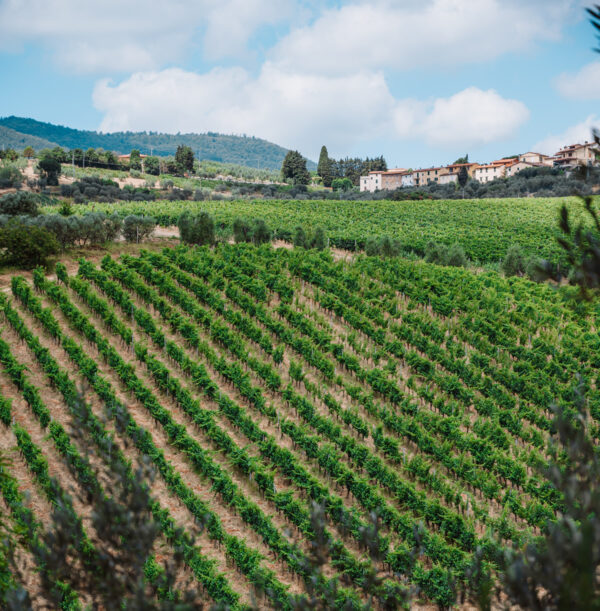
Carmignano landscape and vineyards. Photo: Consorzio Vini Carmignano
Carmignano produces exceptional red wines well-suited for long-aging. Current DOCG regulations require blends be a minimum of 50 percent Sangiovese and between 10 and 20 percent of Cabernet. Originally the mandated grape was Cabernet Franc, but in more recent times Cabernet Sauvignon has been the Cabernet of choice among producers. Both are still used. The remaining permitted grapes are Canaiolo Nero (max 20 percent) and Mammolo and Colorino (max. 5 percent). Riserva wines are aged for a minimum of three years.
The blending of Cabernet Sauvignon with the Sangiovese gives these wines a certain elegance and depth. While Cabernet Franc has been present in Carmignano for centuries, Cabernet Sauvignon was introduced to Carmignano in the 1900s by the Rothschilds who brought vine cuttings from Château Lafite Rothschild in Bordeaux. When DOC Carmigano was established in 1975 it became the first Tuscan production region to sanction the use of Cabernet Sauvignon in the blend. As noted early, DOCG status was granted in 1990.
Two historic wine estates of note in Carmignano illustrate the region’s historic ties to wealth, art and winemaking. We have had the pleasure of visiting both estates and recently spent time with the family proprietors while attending Anteprime Toscana in February.
Tenuta di Artimino
Built in 1596, Villa Medicea ‘La Ferdinanda’ served as a hunting lodge for Count Ferdinando I de’ Medici. Designed by Bernard Buontalenti, the hilltop villa is renowned for its 100 chimneys. Inside are numerous frescoes painted by Italian artists including Passignano and Poccetti. The villa remained privately owned over the years and survived both world wars.
In the 1980s, it was purchased by Giuseppe Olmo (known as “Gepin”), an Olympic bicyclist and entrepreneur. Olmo and his family modernized and expanded to include a luxury hotel and spa operated by Meliá Collection.
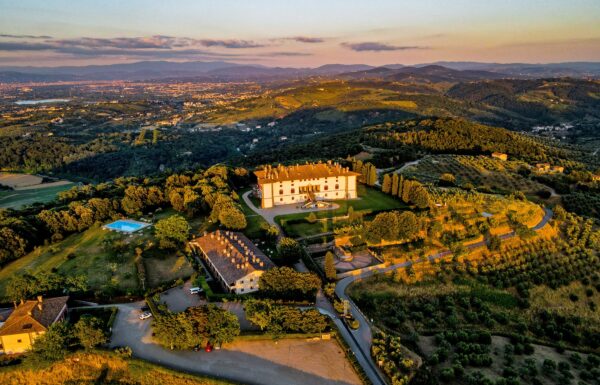
Aerial view of Tenuta di Artimino
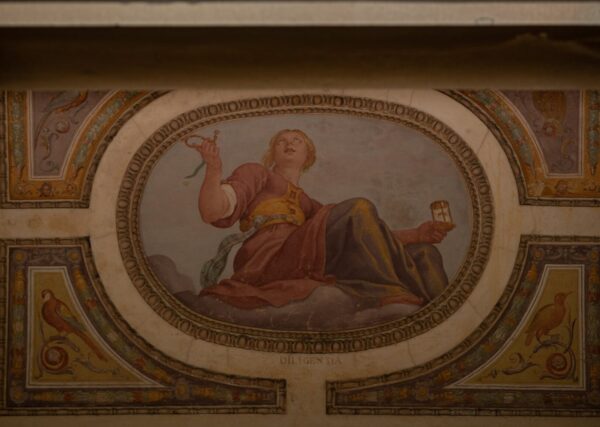
Tenuta di Artimino is named for the local village and is the primary label for its wines and olive oils. The Villa Ferdinando was designated as a UNESCO World Heritage site in 2013 and serves as the hospitality centerpiece and event space.
In 2022 we visited Tenuta di Artimino for a tour and wine tasting and dinner. It is where we first met Annabella Pascale, CEO and granddaughter of Giuseppe Olmo, who led our tour. Following our wine tasting, a candle lit dinner took place in the wine cellar.
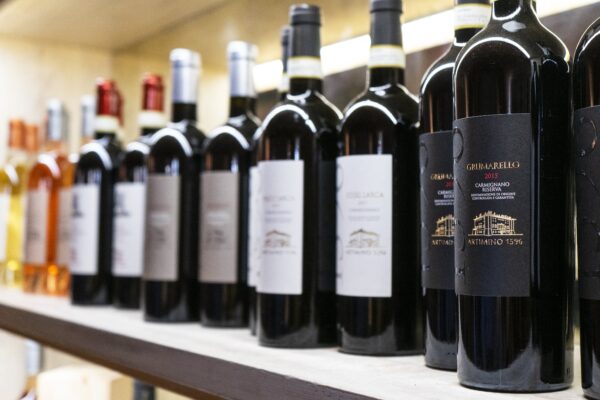
Here are some of the standout wines from Tenuta di Artimino (U.S.A. Siena Imports)
Poggilarca Carmignano DOCG. A blend of Sangiovese and Cabernet Franc.
Grumarello Carmignano DOCG Riserva. A traditional DOCG blend of Sangiovese, Cabernet Sauvignon and Cabernet Franc.
Occhio Pernice Vin Santo di Carmignano DOC sweet wine with flavors of dried figs. walnuts and candied apricot. A blend of Sangiovese (80%), San Columbano and Trebbiano Toscana,
Tenuta di Capezzana
Another important historic wine estate in DOCG Carmignano is Tenuta di Capezzana. One of the oldest wine producers in Tuscany, historic records show wine has been made at Capezzana since 804 A.D. But it was the Contini Bonacossi family who transformed Capezzana from a sharecropping farm to a working agricultural estate producing world-class red wines and olive oils. Originally noble art dealers in Spain, the Contini Bonacossi family acquired Capezzana in 1926. The estate lies within the “Barco Reale,” an ancient hunting preserve established by Grand Duke Fernando II de Medici in 1626, which remains a protected area.
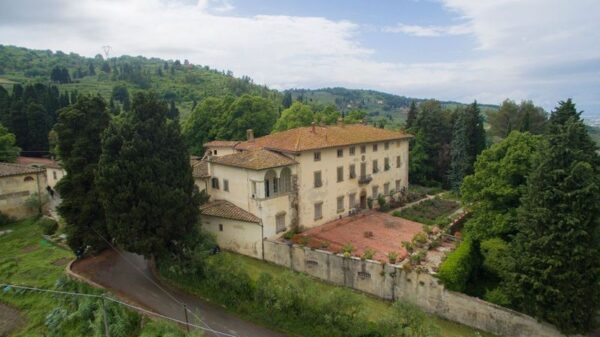
Capezzana is located in the Barco Reale, a protected area in Carmignano.
After World War II, Augusto Alessandro and Ugo Contini Bonacocci, sons of Patriarch Cesare Alessandro Contini Bonacossi, focused on modernization, turning the estate into the world-class wine producer that it is today. This year, the Contini Bonacossi family celebrated the 100th vintage of Tenuta di Capezzana by carefully opening one of only 30 remaining wines from the 1925 vintage, the first release under their ownership.
We were fortunate guests at the dinner held at Il Tornabuoni, in Florence. The evening started with a historical vertical tasting of Tenuta di Capezzana wines from 1995, 1985, 1975 and 1925. While all four wines showed beautifully, we were impressed with how well both the 1975 and 1925 demonstrated solid staying power. A multi-course dinner was paired with Villa di Capezzana wines from the 2005, 2015 and 2021 vintages along with selections of other estate’s wines including Ugi Contini Buonacossi IGT Toscana 2021, Ghiaie della Furba IGT Toscana 2021, Trefiano Carmignano 2020 DOCG Riserva and Vin Santo di Carmignano Riserva DOC 2017. (U.S.A. importer: Dalle Terra).
The Contini Bonacassi family are consummate hosts whether presiding over dinners in Florence or New York which we have attended or welcoming visitors to Tenuta di Capezzana. We visited a few years ago for an overnight stay at the on-site agriturismo, a tour of the estate and its historic cellar, a wine tasting, cooking demonstration and lunch. Family proprietor, Beatrice Contini Bonacossi (Bea), serves at Capezzana’s international ambassador. Her sister, Benedetta oversees winemaking. A special touch was joining Serena Contini Bonacossi, who oversees hospitality, for a visit to the Gallerie degli Uffizi to view an exhibit of the family’s impressive private art collection which they bequeathed to the museum.
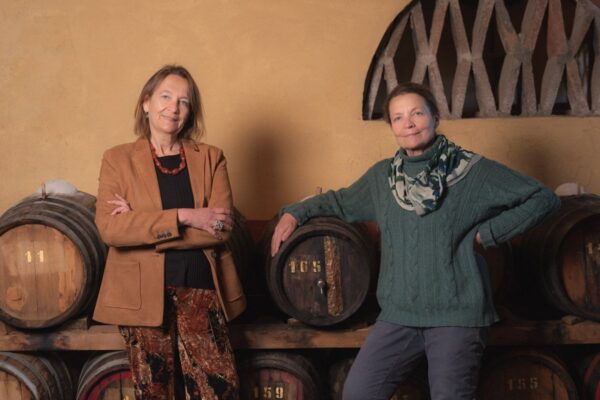
Beatrice (Bea) and Benedetta Contini Bonacossi in the Capezzana wine cellar
Capezzana produces several excellent wines under DOCG, DOC and IGT designations. Here are a few we have tasted. (U.S. importer: Dalla Terra)
Tenuta di Capezzana Villa Di Capezzana di Carmignano DOCG. This is the estate’s flagship wine which, as noted above, dates to 1925.
Tenuta di Capezzxana Trefiano Carmignano DOCG Riserva. Made only in special vintages, the grapes for this wine are sourced from the historic Villa di Trefiano located on the family’s property.
Tenuta di Capezzana Vin Santo DOC Riserva. This exceptional sweet wine is made from selected Trebbiano Toscana grapes that are air dried, then fermented and matured for over six years in small chestnut, oak and cherrywood kegs known as “caratelli.”
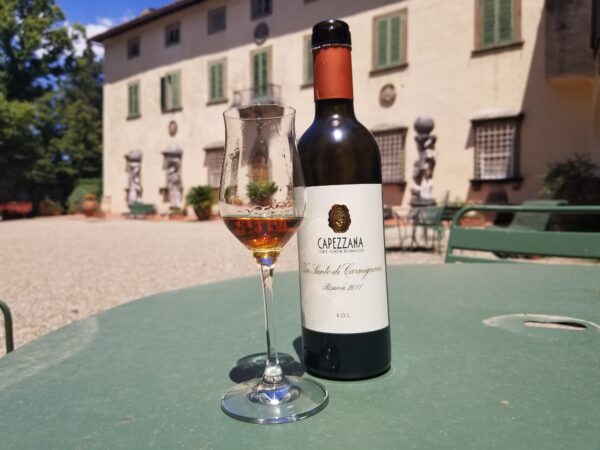
A view of the villa with a glass of Capezzana Vin Santo Riserva 2011
Both Tenuta di Capezzana and Tenuta di Artimino illustrate the history and provenance of Carmignano and offer exceptional visitor experiences. The wines represent the best of the DOCG but not all. There are many more to taste and discover.
Here are links to our interviews with Annabella Pascale, Tenuto di Artimino (original air date July 6, 2022) and Beatrice Contini Bonacossi (original air date: February 23 2023). You can listen to all our podcast library, now 12 years strong- on more than 65 channels. Or listen at here at www.theconnectedtable.com.
